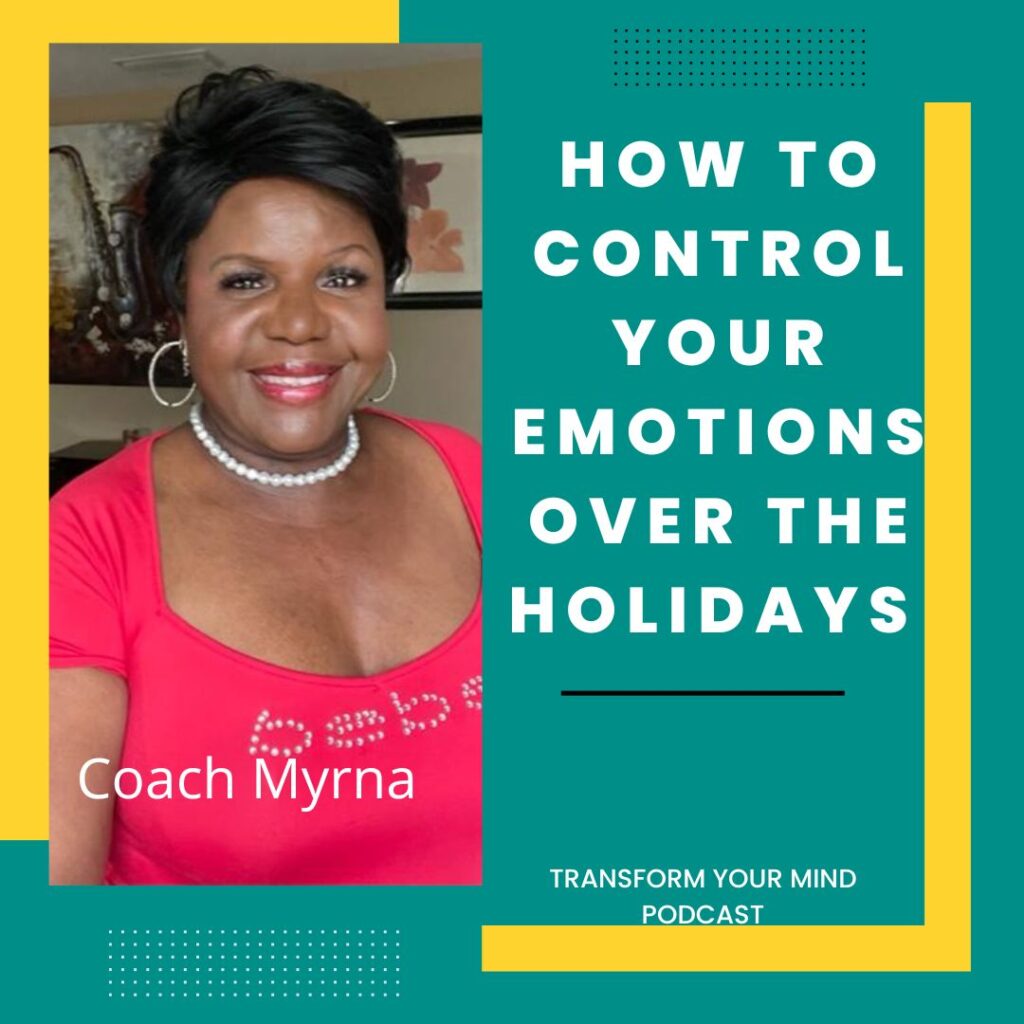How to control your emotions, by taking control of your thoughts you can free yourself from the pain of old wounds, loneliness, feelings of not good enough as you expand your consciousness and well-being.
Today I want to talk on the subject “ 7 steps on, how to control of your emotions” I think the time is apt for this conversation because we are entering the Holiday season and a large percentage of us will be wishing for things to be different. If you are single, you will be wishing you had someone to share Christmas and New Years with, if you are in an unhealthy relationship, these is nothing like the holidays to point that out and then there are those who have lost loved ones, we always remember them during the, holidays.
Download the podcast here
Don’t be Hijacked by your emotions over the holidays
So, with that being said, the, holidays, have gained a bad reputation for being an emotional roller coaster. Instead of experiencing a season of peace, many people dread this time of year as a season of stress and frayed, emotions. But it doesn’t have to be this way. You can bring the gift of peace to yourself by following seven steps of, emotional release. By taking control of your, emotions, you can free yourself from the pain of old wounds, loneliness, feelings of not good enough as you expand your consciousness and well-being.
Here are 7 Steps on, how to control of your emotions. Take your time with each step, staying with it until you feel a sense of completion before moving on to the next one.

How to Control Your Emotions
Step 1: Take Responsibility for Your Own Feelings
Step 1 on, how to control your emotions, is take responsibility for your own feelings. When someone has hurt or wronged you, there’s a tendency to hold onto blame and accusation, or a wish that the other person will ask for forgiveness and express how sorry they are for what they’ve done to you. Such wishes almost never come true, and when you keep holding onto, toxic emotions, you only victimize yourself.
To begin to change this situation, first, take responsibility for your, feelings. This isn’t the same as blaming yourself or finding an excuse to let the person who hurt you off the hook. Instead, you say to yourself, “No one is feeling this hurt (or anger or resentment) except me; therefore, it is up to me to do something about it. I accept responsibility for how I feel.”

Step 2: Witness the Emotion with Detachment
Step 2 on, how to control your emotions, is to become a witness to your emotions. There are only two ways in which you can relate to an old emotion: either with attachment or, detachment. If you are attached, then a reminder of the past brings back the old hurt or wrong, and you vividly relive the, toxic emotions, all over again. When you are detached, on the other hand, an old feeling doesn’t trigger you; you can feel it without getting mired in emotional upset.
To make the shift from attachment to, detachment, recall the emotional situation you want to release, sitting calmly and letting it return. Instead of thinking about the situation or the people involved, close your eyes and feel your body. Let your attention easily go to any tightness, strain, discomfort, or ache. Don’t force anything. If the sensation is too intense, take a deep breath and open your eyes—this will bring you out of contact with the sensation.
If the sensation is manageable, visualize a white light infusing the area where the sensation is occurring. After a few seconds, see the white light exiting your body as you exhale. Have the intention of sending the old, emotions, away. Do this exercise for a few minutes until the sensation lessens. You don’t have to release it completely—often old, stuck emotions, take some repetition, one session per day, to complete the release, or even more if you are releasing a deep, long-held experience.
The key to, detachment, is to avoid mentally replaying the old situation all over again. Instead, put your attention entirely on the physical response being held inside the body, which gives you the ability to be more detached.

Step 3: Express the Emotion
Step 3 in, how to control your emotions, is not hold your emotions in. Putting, feelings, into words helps in two ways: it gives you greater clarity and access to the emotion you want to release, and it gives your mind something positive to do in the releasing process. The technique of expressing the emotion has three parts.
- Part One: Write down the whole story of this old emotion, recalling who did what, how you felt, and the consequences that followed. Leave nothing out when describing how hurt, outraged, abused, betrayed, or victimized you felt. This is your first-person account of what happened and how you felt.
- Part Two: Now write down the same story as the other person in the situation would tell it. Your first-person account switches to a second-person account. With just as much detail, relate the other side of the story. Don’t insert your own blame or judgments. As in a courtroom, the other person is telling their side of the story.
- Part Three: Finally, put on a reporter’s hat and tell the story again, this time in the third person. Imagine that a journalist or detective is investigating the situation and is writing an objective report about what happened.

Step 4: Share the Experience with Someone You Love and Trust
The next step is to share your experience with a close confidant, such as a friend or family member. Important note: If your emotion is rooted in a traumatic experience or a secret shame that you have never shared with anyone, it’s best to seek the help of a professional therapist.
In all likelihood, your friends and family have already heard your complaints. This time, however, relate the three steps you have just taken. Instead of seeking sympathy for your injuries or asking for help or commiseration, now you are unveiling how you intend to heal and release this old painful, emotions.
Just by sharing your process of, emotional release, you deepen your commitment to it. At the same time, the release will begin to feel more real because others have been brought into the process.

Step 5: Reflect on the Emotion
Step 5 in controlling your emotions is reflection. By now, the stuck emotion has started to dislodge. You are no longer trapped by it and victimized by past events. Take some time and ask yourself a critical question: Is holding on helping me or making the situation worse? Don’t ask this superficially and be sure to reflect deeply on what is true. There is a perverse satisfaction we all feel when nursing our wounds and grudges. In fantasy, we exact all kinds of payback and punishment, which can feel like it’s helping us when it’s only reinforcing our pain.
If you still feel stuck in old, emotions, be patient with yourself. Wait until you feel calmer and more centered. Perhaps you might want to repeat the previous steps a second time. It is essential that you see, very clearly and rationally, that your interpretation of events—and the, painful emotions, resulting from it—isn’t helping you. It has closed off an avenue of openness, trust, and inner peace.

Step 6: Release Through a Ritual That Is Memorable
A ritual is like drawing a line in the sand, stepping over it, and not looking back. Such a ritual is important with deep, long-held feelings. You have consciously been working toward the moment of, emotional release. Make the ritual one that you will remember. It is up to you whether the ritual will be private or shared with others close to you.
What kind of ritual? Some people write down the story of their process up to this point and burn the paper in a beach bonfire, throwing the ashes out to sea or into the wind. Others take a rock or stone and symbolically “charge” it with their story and, emotions, before casting it into the ocean or a river. A ritual can be made out of tossing away old mementos and photos. Be creative and choose something that will stick in your mind as a decisive turning point.
Step 7: Celebrate the Release
This step is self-explanatory, but remember to include it. When stuck, emotions, are released, there’s a gap or hole where it used to be. You want to fill it with lightness and joy. You want to congratulate yourself for truly accomplishing something. A celebration of the most positive kind, in the spirit of renewal, is called for.
By using this process consistently, you will gradually be able to let go of old hurts and resentment, freeing yourself to experience your inherent state of peace and well-being. This is a gift not only to yourself but to everyone in your life and the world beyond.
Additional Resources









